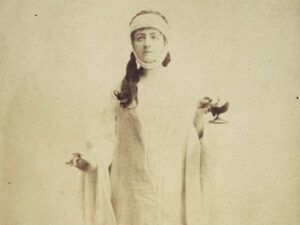An anti-heroine is the opposite of a heroine. According to both the Oxford English Dictionary and Wikipedia, it means ‘lacking’ traditional heroic qualities – things like bravery, strength and morality.
An anti-heroine is a female protagonist who is not confined by the expectations put upon them, someone who makes ‘unconventional life choices’. The trouble is, conventions and expectations have always had an awful lot to do with gender. So what I came to understand was that being an anti-heroine meant rocking the boat, no longer being feminine, becoming ‘other’.
These days, our definition of what it means to be feminine is much broader than that which constrained the authors of the characters outlined below. So categorising these characters as anti-heroines now starts to feel problematic. They all break the feminine mould of their time – whether or not they possess beauty, none of them will tow the line, they follow their own desires, they stand up for themselves.
It is exactly this anti-heroic ‘bad behaviour’, and determination to ‘defy conventional ethical codes’ that makes them real and relatable. To characterise them as ‘anti-heroic’ and therefore ‘lacking’, seems wrong. They are strong, independent, courageous, passionate, tempestuous, intelligent, angry, sometimes even evil. And they show us that even when a life is constrained by behavioural codes relating to patriarchy, marriage and motherhood, that it is ok to want more than that, to find a way to get more than that. They tell us that what a woman wants for herself matters more than what society expects of her. That shows great bravery, strength and morality, doesn’t it? It makes them not ‘anti-heroic’ but bonafide ‘heroic’.
However you want to categorise them, here are five box-breakers from great European literature:
1. Jane Eyre, of Jane Eyre, by Charlotte Brontë
Despite being from the fusty old Victorian era, Jane was a breath of fresh air to me. Jane is orphaned early on, (solid way to start a story – see nearly every Disney movie), but she is not blessed with the other heroic Disney trope of beauty. Nor is she given to going along with things that she does not agree with. So, ugly and disagreeable, she must instead have a personality. And it’s a great one. Go and read it.
2. Madame Bovary, of Madame Bovary, by Gustave Flaubert
A girl with big ambition trapped within a stiflingly domestic and pedestrian existence. These days, she’d be running a blog with a lot of swearing in it about what a terrible parent she was whilst swiping right on an anonymous profile on Tinder. But in mid-19th century France, married to an unobservant and unexciting local doctor, she had to get her kicks from reading romantic novels and failing at a series of adulterous affairs.
3. Lady Macbeth, of Macbeth, by William Shakespeare
The epitome of the cliché that behind every great man, there’s a great woman. If by great, you mean cunning and murderous. When he’s doubting his ability to kill King Duncan, she’s right there behind him, handing him the knife and pushing him out the door. Strong, ambitious, well-organised. Hygienic. And ultimately driven to madness by guilt. I’m not sure whether this one is an anti-heroine or a plain old villain. Either way, she’s impressive.
4. Anna Karenina, of Anna Karenina by Leo Tolstoy
A beautiful and intoxicating woman in high society, the subject of several people’s infatuations, she succumbs eventually to an affair, falls madly in love and realises that her marriage offers little joy. Forthright, independent and determined, she runs away from her husband to be with her lover. Unfortunately, it doesn’t end well.
5. Catherine Earnshaw of Wuthering Heights, by Emily Brontë
Heathcliff is the stray child, and Catherine the headstrong daughter of the house who falls for him but marries someone else of better social standing. In a storyline twist, Heathcliff becomes suddenly wealthy, but Catherine remains a faithful wife and then dies tragically young (aged 18) so they never manage to get together. At least not in life. She comes back to haunt Heathcliff and he dies in her old bedroom before being buried next to her.
Great female characters in European literature! Those that break the mould!
Further information
View Jane Eyre material on Europeana Collections
View Madame Bovary material on Europeana Collections
View material relating to Lady Macbeth on Europeana Collections
View Anna Karenina material on Europeana Collections
View Anna Karenina material on Europeana Collections







Leave a Reply